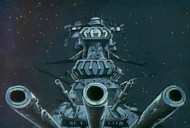
Space Battleship Yamato: The Movie
Star Blazers started it all. As much as those of my generation would like to claim that anime fandom in the United States started with Robotech, there is no doubt that the seeds were planted by the English-language version of the television show Space Battleship Yamato. While Star Blazers faded in the US shortly after its 1979 debut, fans kept its memory alive through showings at sci-fi conventions. Meanwhile, Japan enjoyed three seasons of Space Battleship Yamato on TV and several movies that told the tale of the WWII submarine retro-fitted for space combat. Despite its age, true anime fans still are aware of the show, even though a proper subtitled version of the original series has never been released.
The first film, which also came under the moniker Space Battleship Yamato, was released in 1977, and it is the only legal way to see any of the original TV series in the United States in its original language. This film is really responsible for the initial surge in the show's popularity in Japan; while it was only modestly successful during its television run, the film's release was perfectly timed to ride the massive wave of sci-fi interest with the advent of Star Wars, and it created the demand that surged until the mid-'80s. Now celebrating its 30th anniversary, Space Battleship Yamato is an oddity, a film made in a style that no longer exists. It's extremely creaky, especially in its boring first hour, but those with endurance and a strong tolerance for cartoonish animation styles might enjoy the second hour, which tightens up the narrative and offers some excitement even today.
By the year 2199, the planet Gamilus has launched a massive attack on Earth. Themselves a people from a dying world, they annihilate the surface of the planet with deadly radiation bombs to destroy humanity and make the planet hospitable for themselves. The remains of humanity live underground, fearful of extinction and watching as Earth's defense forces are massively outgunned. In about a year, the planet will be so severely radiated that it will no longer be inhabitable, even in the underground cities.
When all appears lost, Kodai and his friend Shima find a crashlanded ship on Mars. Its pilot is dead, but she carries with her a recorded message from the planet Iscandar: come! The message includes plans for a Wave Motion Engine that can be used to reach across the vast difference between the planets in less than a year's time...and Starsha, the sender of the message, promises technology that can reverse the effects of the radiation bombs. Earth's remnant puts together the engine in the hull of the ancient cruiser Yamato, a submarine that was sunk during WWII. Fitted for space duty, the Yamato is the only hope for humanity. Led by Captain Okita, Kodai, and their stalwart comrades, Yamato will have to make it through all of Gamilus' defenses before they make the long trip to Iscandar and race home before Earth is a complete wasteland.
With character designs by Leiji Matsumoto, the man behind Captain Harlock and Interstella 5555, there's genuine talent behind what appears on screen. However, Space Battleship Yamato is a mess as far as modern standards are concerned. Almost all of the footage in the film is recycled from the television series, which was on a limited budget even then! As such, it looks nothing like what modern audiences expect from an anime film. Nothing is detailed, period. The spaceships have the barest features, and they look ridiculous. Explosions are reddish fireballs that will make you laugh the first time you see them. We're lucky that the skyscrapers actually have windows! While the characters don't look bad, it takes quite a while to get past the ship designs, which at best look juvenile and at worst look like they were drawn by amateurs. Perhaps I exaggerate, but I do so to avoid anyone looking at this show expecting anything but the most stereotypically bad 1970s visuals possible.
That's not the only stumbling block many will find in Space Cruiser Yamato, however. The instrumental music is really quite good and, at times, even stirring and moving. It is limited by the instrumentation preferences of the time, such as wah-pedal-happy guitarists, but I really enjoyed the soundtrack. It has hints of what made the score to Macross so wildly successful. (In fact, I listened to the soundtrack when writing this review, which I rarely do.) However, the vocal tracks will likely send giggles throughout a crowd. They are over the top. They include girls in the background singing "ah-ha-ah" in ways reminiscent of the original Star Trek theme. To top it off, the film starts in pitch darkness for over a minute while the theme song plays, narrating briefly what you'll see. For those extremely sensitive to cheese, you might not actually see any animation before you decide it's all too much.
For those still willing to brave it, there's one more problem: Space Battleship Yamato is really two movies. The first movie is a compilation of the vast majority of the TV show's plot. To condense all the adventures of Yamato into 2:15 while not leaving out anything required a huge amount of setup, and this was in the days before everyone could get caught up on a TV show by watching it on DVD (or even VHS). Thus, a frightful amount of stoicly serious narration is used to guide the audience through all the events during the first hour. While it meant nothing for a TV show, Kodai isn't introduced until over 11 minutes into the movie, and it isn't clear until much later that he is supposed to be our hero! We really don't even get "Yamato's greatest hits" in that we get to see only snippets of battles while the narrator tells us the outcomes. The first hour is a slog to get through. And even when that hour is over, relationships get shortchanged for plot. For example, it's not clear that Kodai has a romantic relationship with crewmate Yuri until they get a minute-long interlude where she playfully jokes about eventually having their children. Where did the rest of their relationship go? It's still back in the TV series.
That said -- and no doubt, there are a lot of negatives in there -- Yamato still works because of its second hour. The narrator disappears for considerable stretches of time, and we get what was clearly the strength of the TV show: wonderful narrative tension. We are presented with two full battles, one against Lord Domel and another in a fiery lava ocean. (I won't say more for spoiler's sake.) Both put the ship and crew in real peril, and for all the boredom of the first hour, it becomes a nail-biter. The warfare shows real tactics in play, and they are exciting to watch. And despite the lack of character development, the show focuses enough on the leads enough that by the time the second half plays, it matters. The ending is so strong, in fact, that it made me rethink the beginning. No, I can't ignore the problems, but I can say that there's a real payoff for the patient and forgiving.
What's more, the second half of Space Battleship Yamato shows the real potential of the television series. It's clear that the parts of the movie that are most entertaining are those when the narrative runs flat-out for twenty minutes or so...the length of a television episode. It's sad that there is no release of the original Japanese series, since Star Blazers was edited for American sensibilities; some deaths simply didn't happen, some characters had minor personality changes, and so forth. Nevertheless, I am intrigued enough to consider picking up some Star Blazers episodes to see the original form of what appears in this movie. If it runs as well as the second half of this film, then it's surely a must-see.
From all that I've read, this is easily the weakest of the Yamato movies, and they continue to get better and better. I can only give this the barest of recommendations, not only because of the lifeless first half but also because of the elements that will make this a loss for a good segment of my reading audience. However, there's enough here to like not to throw it out. I probably won't watch it again, but it makes me interested in finding out more about the rest of the Yamato canon.
Space Battleship Yamato -- violence, mild profanity -- B-

